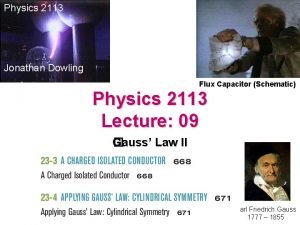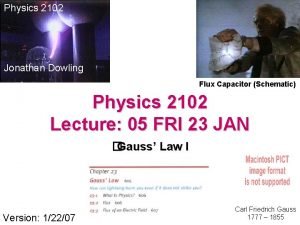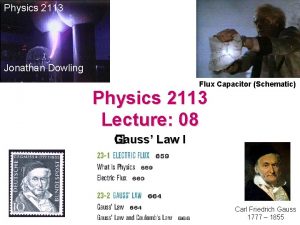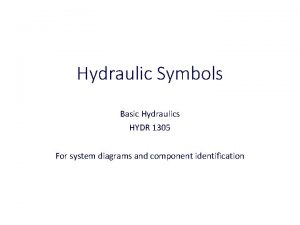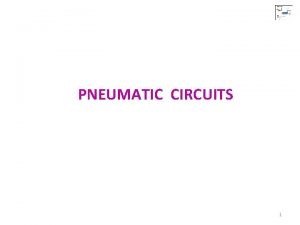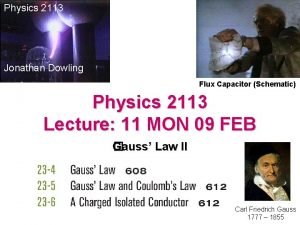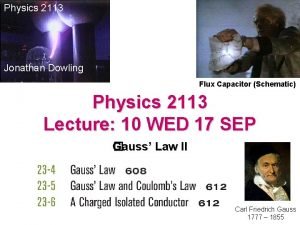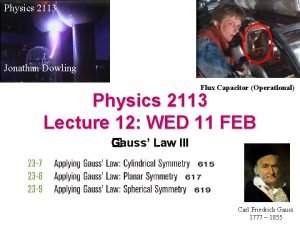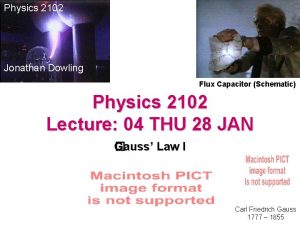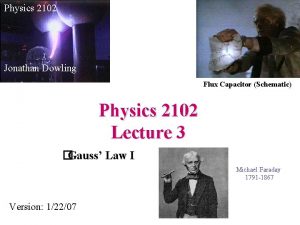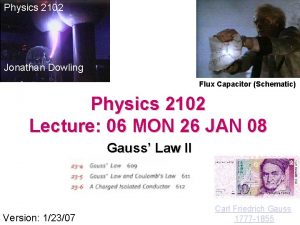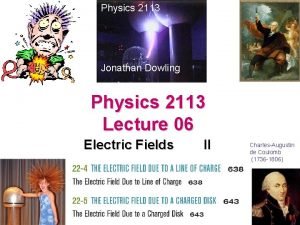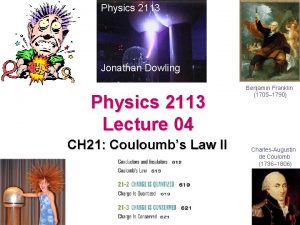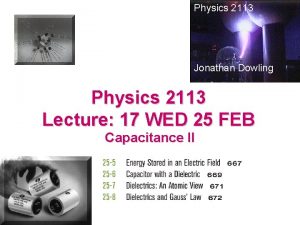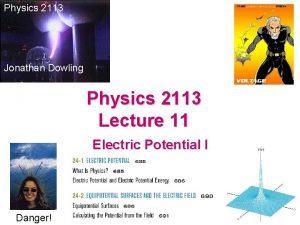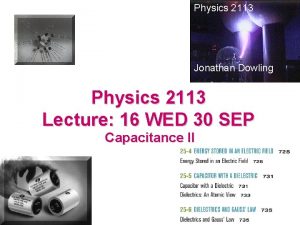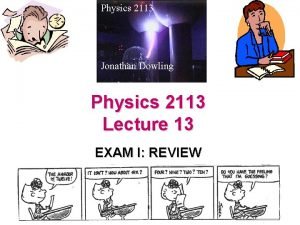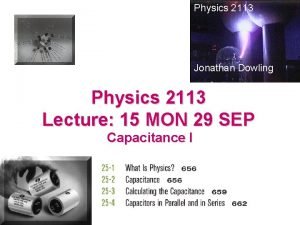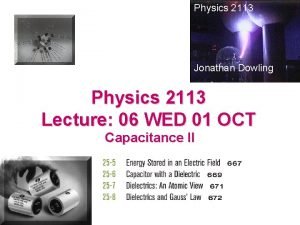Physics 2113 Jonathan Dowling Flux Capacitor Schematic Physics























- Slides: 23

Physics 2113 Jonathan Dowling Flux Capacitor (Schematic) Physics 2113 Lecture: 09 Gauss � Gauss’ Law II Carl Friedrich Gauss 1777 – 1855

Gauss’ Law: General Case • Consider any ARBITRARY CLOSED surface S -- NOTE: this does NOT have to be a “real” physical object! S • The TOTAL ELECTRIC FLUX through S is proportional to the TOTAL CHARGE ENCLOSED! • The results of a complicated integral is a very simple formula: it avoids long calculations! (One of Maxwell’s 4 equations!)

Gauss’ Law: ICPP


23 -3 A Charged Isolated Conductor Learning Objectives • • • 23. 14 Apply the relationship between surface charge density σ and the area over which the charge is uniformly spread. 23. 15 Identify that if excess charge (positive or negative) is placed on an isolated conductor, that charge moves to the surface and none is in the interior. 23. 16 Identify the value of the electric field inside an isolated conductor. • • • 23. 17 For a conductor with a cavity that contains a charged object, determine the charge on the cavity wall and on the external surface. 23. 18 Explain how Gauss’ law is used to find the electric field magnitude E near an isolated conducting surface with a uniform surface charge density σ. 23. 19 For a uniformly charged conducting surface, apply the relationship between the charge density σ and the electric field magnitude E at points near the conductor, and identify the direction of the field vectors.

Properties of Conductors Inside a Conductor in Electrostatic Equilibrium, the Electric Field Is ZERO. Why? Because If the Field Is Not Zero, Then Charges Inside the Conductor Would Be Moving. SO: Charges in a Conductor Redistribute Themselves Wherever They Are Needed to Make the Field Inside the Conductor ZERO. Excess Charges Are Always on the Surface of the Conductors.

ICPP: Conducting Sphere • A spherical conducting shell has an excess charge of +10 C. • A point charge of – 15 C is located at center of the sphere. • Use Gauss’ Law to calculate the charge on inner and outer surface of spherical shell (a) Inner: +15 C; outer: 0 (b) Inner: 0; outer: +10 C (c) Inner: +15 C; outer: – 5 C Hint: E-Field is Zero inside conductor so R 2 +10 C R 1 – 15 C

Gauss’ Law: Conducting Sphere • Inside a conductor, E = 0 under static equilibrium! Otherwise electrons would keep moving! • Construct a Gaussian surface inside the metal as shown. (Does not have to be spherical!) – 5 C • Since E = 0 inside the metal, flux through this surface = 0 • Gauss’ Law says total charge enclosed = 0 • Charge on inner surface = +15 C Since TOTAL charge on shell is +10 C, Charge on outer surface = +10 C - 15 C = -5 C! +15 C – 15 C

Faraday’s Cage • Given a hollow conductor of arbitrary shape. Suppose an excess charge Q is placed on this conductor. Suppose the conductor is placed in an external electric field. How does the charge distribute itself on outer and inner surfaces? (a) Inner: Q/2; outer: Q/2 (b) Inner: 0; outer: Q (c) Inner: Q; outer: 0 • Choose any arbitrary surface inside the metal • Since E = 0, flux = 0 • Hence total charge enclosed = 0 All charge goes on outer surface! Safe in the Plane!? Inside cavity is “shielded” from all external electric fields! “Faraday Cage effect”

Safe in the Plane!? Faraday’s Cage: Electric Field Inside Hollow Conductor is Zero Safe in the Car!? E=0 • Choose any arbitrary surface inside the metal • Since E = 0, flux = 0 • Hence total charge enclosed = 0 All charge goes on outer surface! Inside cavity is “shielded” from all external electric fields! “Faraday Cage effect”


Field on Conductor Perpendicular to Surface We know the field inside the conductor is zero, and the excess charges are all on the surface. The charges produce an electric field outside the conductor. On the surface of conductors in electrostatic equilibrium, the electric field is always perpendicular to the surface. Why? Because if not, charges on the surface of the conductors would move with the electric field.

Charges in Conductors • Consider a conducting shell, and a negative charge inside the shell. • Charges will be “induced” in the conductor to make the field inside the conductor zero. • Outside the shell, the field is the same as the field produced by a charge at the center!

Gauss’ Law: Conducting Plane • Infinite CONDUCTING plane with uniform areal charge density s • E is NORMAL to plane • Construct Gaussian box as shown. • Note that E = 0 inside conductor

Gauss’ Law: Conducting ICPP • Charged conductor of arbitrary shape: no symmetry; non-uniform charge density • What is the electric field near the surface where the local charge density is σ ? (a) σ/ε 0 (b) Zero (c) σ/2ε 0 + + ++ + + + E = 0 THIS IS A GENERAL RESULT FOR CONDUCTORS!

23 -4 Applying Gauss’ Law: Cylindrical Symmetry Learning Objectives • • 23. 20 Explain how Gauss’ law is used to derive the electric field magnitude outside a line of charge or a cylindrical surface (such as a plastic rod) with a uniform linear charge density λ. 23. 21 Apply the relationship between linear charge density λ on a cylindrical surface and the electric field magnitude E at radial distance r from the central axis. • 23. 22 Explain how Gauss’ law can be used to find the electric field magnitude inside a cylindrical non-conducting surface (such as a plastic rod) with a uniform volume charge density ρ. © 2014 John Wiley & Sons, Inc. All rights reserved.

23 -4 Applying Gauss’ Law: Cylindrical Symmetry Figure shows a section of an infinitely long cylindrical plastic rod with a uniform charge density λ. The charge distribution and the field have cylindrical symmetry. To find the field at radius r, we enclose a section of the rod with a concentric Gaussian cylinder of radius r and height h. A Gaussian surface in the form The net flux through the cylinder from of a closed cylinder surrounds a Gauss’ Law reduces to section of a very long, uniformly charged, cylindrical plastic rod. yielding © 2014 John Wiley & Sons, Inc. All rights reserved.

Gauss’ Law: Cylindrical Symmetry • Charge of q = 10 C is uniformly spread over a line of length L = 1 m. E=? • Use Gauss’ Law to compute magnitude of E at a perpendicular distance of 1 mm from the center of the line. r = 1 mm L=1 m • Approximate as infinitely long line — E radiates outwards. • Choose cylindrical surface of radius r, length L co-axial with line of charge. Line of Charge: λ = q/L Units: [C/m]

Gauss’ Law: Cylindrical Symmetry • Approximate as infinitely long line — E radiates outwards. • Choose cylindrical surface of radius r, length L co-axial with line of charge. E=? r = 1 mm L=1 m d. A || E so cos θ = 1

Compare to Finite Line Example From Last Week! • Add the Vectors! • Horrible Integral! • Trig Substitution! r If the Line Is Infinitely Long (L >> r) … Blah, Blah… With Gauss’s Law We Got Same Answer With Two Lines of Algebra! r

A-Rod


 Flux capacitor schematic
Flux capacitor schematic Flux capacitor schematic
Flux capacitor schematic Electric flux capacitor
Electric flux capacitor Flux capacitor schematic
Flux capacitor schematic Jonathan dowling
Jonathan dowling E=q/ae0
E=q/ae0 Capacitor discharge circuit schematic
Capacitor discharge circuit schematic Comp 2113
Comp 2113 Art.2113 cc
Art.2113 cc Afi 36-2113
Afi 36-2113 Remanent magnetization
Remanent magnetization Flux weber
Flux weber Dowling roundabout
Dowling roundabout International human resource management dowling 6th edition
International human resource management dowling 6th edition Dowling optical
Dowling optical Shock mnemonic
Shock mnemonic Martens schematic theory
Martens schematic theory Natty boh building
Natty boh building Intraplate plume
Intraplate plume Schematic diagram of abrasive jet machining
Schematic diagram of abrasive jet machining Marshall mg10 schematic
Marshall mg10 schematic Intel 4004 schematic
Intel 4004 schematic Lever operator symbol
Lever operator symbol How single acting cylinder works
How single acting cylinder works
